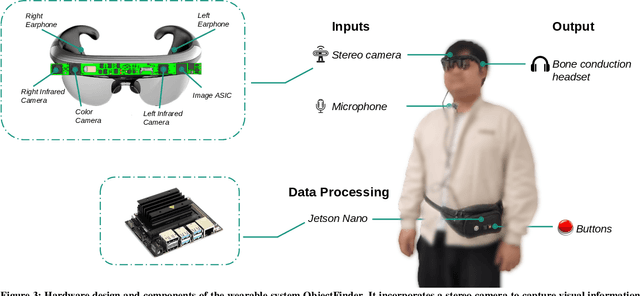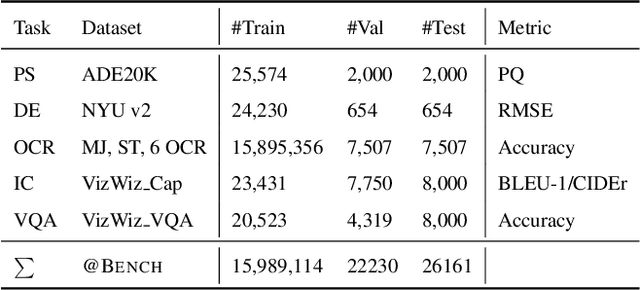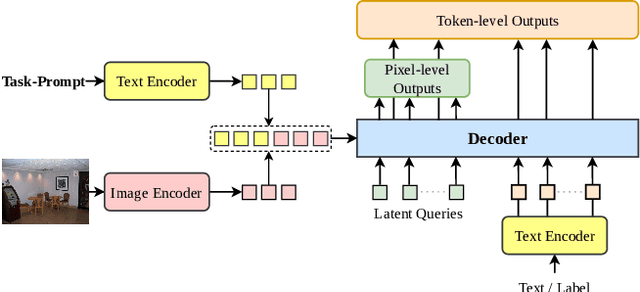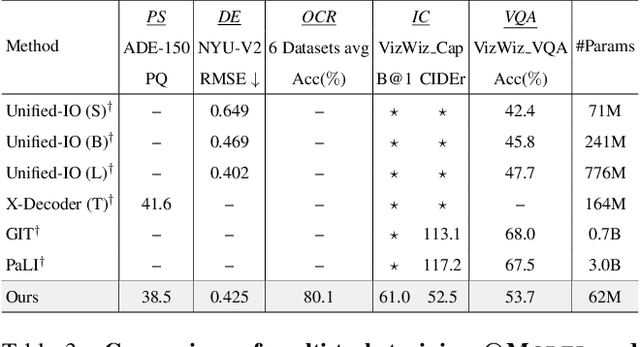Ruiping Liu
EReLiFM: Evidential Reliability-Aware Residual Flow Meta-Learning for Open-Set Domain Generalization under Noisy Labels
Oct 14, 2025Abstract:Open-Set Domain Generalization (OSDG) aims to enable deep learning models to recognize unseen categories in new domains, which is crucial for real-world applications. Label noise hinders open-set domain generalization by corrupting source-domain knowledge, making it harder to recognize known classes and reject unseen ones. While existing methods address OSDG under Noisy Labels (OSDG-NL) using hyperbolic prototype-guided meta-learning, they struggle to bridge domain gaps, especially with limited clean labeled data. In this paper, we propose Evidential Reliability-Aware Residual Flow Meta-Learning (EReLiFM). We first introduce an unsupervised two-stage evidential loss clustering method to promote label reliability awareness. Then, we propose a residual flow matching mechanism that models structured domain- and category-conditioned residuals, enabling diverse and uncertainty-aware transfer paths beyond interpolation-based augmentation. During this meta-learning process, the model is optimized such that the update direction on the clean set maximizes the loss decrease on the noisy set, using pseudo labels derived from the most confident predicted class for supervision. Experimental results show that EReLiFM outperforms existing methods on OSDG-NL, achieving state-of-the-art performance. The source code is available at https://github.com/KPeng9510/ERELIFM.
MICA: Multi-Agent Industrial Coordination Assistant
Sep 17, 2025Abstract:Industrial workflows demand adaptive and trustworthy assistance that can operate under limited computing, connectivity, and strict privacy constraints. In this work, we present MICA (Multi-Agent Industrial Coordination Assistant), a perception-grounded and speech-interactive system that delivers real-time guidance for assembly, troubleshooting, part queries, and maintenance. MICA coordinates five role-specialized language agents, audited by a safety checker, to ensure accurate and compliant support. To achieve robust step understanding, we introduce Adaptive Step Fusion (ASF), which dynamically blends expert reasoning with online adaptation from natural speech feedback. Furthermore, we establish a new multi-agent coordination benchmark across representative task categories and propose evaluation metrics tailored to industrial assistance, enabling systematic comparison of different coordination topologies. Our experiments demonstrate that MICA consistently improves task success, reliability, and responsiveness over baseline structures, while remaining deployable on practical offline hardware. Together, these contributions highlight MICA as a step toward deployable, privacy-preserving multi-agent assistants for dynamic factory environments. The source code will be made publicly available at https://github.com/Kratos-Wen/MICA.
CHAOS: Chart Analysis with Outlier Samples
May 22, 2025Abstract:Charts play a critical role in data analysis and visualization, yet real-world applications often present charts with challenging or noisy features. However, "outlier charts" pose a substantial challenge even for Multimodal Large Language Models (MLLMs), which can struggle to interpret perturbed charts. In this work, we introduce CHAOS (CHart Analysis with Outlier Samples), a robustness benchmark to systematically evaluate MLLMs against chart perturbations. CHAOS encompasses five types of textual and ten types of visual perturbations, each presented at three levels of severity (easy, mid, hard) inspired by the study result of human evaluation. The benchmark includes 13 state-of-the-art MLLMs divided into three groups (i.e., general-, document-, and chart-specific models) according to the training scope and data. Comprehensive analysis involves two downstream tasks (ChartQA and Chart-to-Text). Extensive experiments and case studies highlight critical insights into robustness of models across chart perturbations, aiming to guide future research in chart understanding domain. Data and code are publicly available at: http://huggingface.co/datasets/omoured/CHAOS.
Exploring Video-Based Driver Activity Recognition under Noisy Labels
Apr 16, 2025Abstract:As an open research topic in the field of deep learning, learning with noisy labels has attracted much attention and grown rapidly over the past ten years. Learning with label noise is crucial for driver distraction behavior recognition, as real-world video data often contains mislabeled samples, impacting model reliability and performance. However, label noise learning is barely explored in the driver activity recognition field. In this paper, we propose the first label noise learning approach for the driver activity recognition task. Based on the cluster assumption, we initially enable the model to learn clustering-friendly low-dimensional representations from given videos and assign the resultant embeddings into clusters. We subsequently perform co-refinement within each cluster to smooth the classifier outputs. Furthermore, we propose a flexible sample selection strategy that combines two selection criteria without relying on any hyperparameters to filter clean samples from the training dataset. We also incorporate a self-adaptive parameter into the sample selection process to enforce balancing across classes. A comprehensive variety of experiments on the public Drive&Act dataset for all granularity levels demonstrates the superior performance of our method in comparison with other label-denoising methods derived from the image classification field. The source code is available at https://github.com/ilonafan/DAR-noisy-labels.
Scene-agnostic Pose Regression for Visual Localization
Mar 25, 2025



Abstract:Absolute Pose Regression (APR) predicts 6D camera poses but lacks the adaptability to unknown environments without retraining, while Relative Pose Regression (RPR) generalizes better yet requires a large image retrieval database. Visual Odometry (VO) generalizes well in unseen environments but suffers from accumulated error in open trajectories. To address this dilemma, we introduce a new task, Scene-agnostic Pose Regression (SPR), which can achieve accurate pose regression in a flexible way while eliminating the need for retraining or databases. To benchmark SPR, we created a large-scale dataset, 360SPR, with over 200K photorealistic panoramas, 3.6M pinhole images and camera poses in 270 scenes at three different sensor heights. Furthermore, a SPR-Mamba model is initially proposed to address SPR in a dual-branch manner. Extensive experiments and studies demonstrate the effectiveness of our SPR paradigm, dataset, and model. In the unknown scenes of both 360SPR and 360Loc datasets, our method consistently outperforms APR, RPR and VO. The dataset and code are available at https://junweizheng93.github.io/publications/SPR/SPR.html.
Graph-based Document Structure Analysis
Feb 04, 2025



Abstract:When reading a document, glancing at the spatial layout of a document is an initial step to understand it roughly. Traditional document layout analysis (DLA) methods, however, offer only a superficial parsing of documents, focusing on basic instance detection and often failing to capture the nuanced spatial and logical relations between instances. These limitations hinder DLA-based models from achieving a gradually deeper comprehension akin to human reading. In this work, we propose a novel graph-based Document Structure Analysis (gDSA) task. This task requires that model not only detects document elements but also generates spatial and logical relations in form of a graph structure, allowing to understand documents in a holistic and intuitive manner. For this new task, we construct a relation graph-based document structure analysis dataset (GraphDoc) with 80K document images and 4.13M relation annotations, enabling training models to complete multiple tasks like reading order, hierarchical structures analysis, and complex inter-element relation inference. Furthermore, a document relation graph generator (DRGG) is proposed to address the gDSA task, which achieves performance with 57.6% at mAP$_g$@0.5 for a strong benchmark baseline on this novel task and dataset. We hope this graphical representation of document structure can mark an innovative advancement in document structure analysis and understanding. The new dataset and code will be made publicly available at https://yufanchen96.github.io/projects/GraphDoc.
ObjectFinder: Open-Vocabulary Assistive System for Interactive Object Search by Blind People
Dec 04, 2024



Abstract:Assistive technology can be leveraged by blind people when searching for objects in their daily lives. We created ObjectFinder, an open-vocabulary interactive object-search prototype, which combines object detection with scene description and navigation. It enables blind persons to detect and navigate to objects of their choice. Our approach used co-design for the development of the prototype. We further conducted need-finding interviews to better understand challenges in object search, followed by a study with the ObjectFinder prototype in a laboratory setting simulating a living room and an office, with eight blind users. Additionally, we compared the prototype with BeMyEyes and Lookout for object search. We found that most participants felt more independent with ObjectFinder and preferred it over the baselines when deployed on more efficient hardware, as it enhances mental mapping and allows for active target definition. Moreover, we identified factors for future directions for the development of object-search systems.
@Bench: Benchmarking Vision-Language Models for Human-centered Assistive Technology
Sep 21, 2024



Abstract:As Vision-Language Models (VLMs) advance, human-centered Assistive Technologies (ATs) for helping People with Visual Impairments (PVIs) are evolving into generalists, capable of performing multiple tasks simultaneously. However, benchmarking VLMs for ATs remains under-explored. To bridge this gap, we first create a novel AT benchmark (@Bench). Guided by a pre-design user study with PVIs, our benchmark includes the five most crucial vision-language tasks: Panoptic Segmentation, Depth Estimation, Optical Character Recognition (OCR), Image Captioning, and Visual Question Answering (VQA). Besides, we propose a novel AT model (@Model) that addresses all tasks simultaneously and can be expanded to more assistive functions for helping PVIs. Our framework exhibits outstanding performance across tasks by integrating multi-modal information, and it offers PVIs a more comprehensive assistance. Extensive experiments prove the effectiveness and generalizability of our framework.
OneBEV: Using One Panoramic Image for Bird's-Eye-View Semantic Mapping
Sep 20, 2024Abstract:In the field of autonomous driving, Bird's-Eye-View (BEV) perception has attracted increasing attention in the community since it provides more comprehensive information compared with pinhole front-view images and panoramas. Traditional BEV methods, which rely on multiple narrow-field cameras and complex pose estimations, often face calibration and synchronization issues. To break the wall of the aforementioned challenges, in this work, we introduce OneBEV, a novel BEV semantic mapping approach using merely a single panoramic image as input, simplifying the mapping process and reducing computational complexities. A distortion-aware module termed Mamba View Transformation (MVT) is specifically designed to handle the spatial distortions in panoramas, transforming front-view features into BEV features without leveraging traditional attention mechanisms. Apart from the efficient framework, we contribute two datasets, i.e., nuScenes-360 and DeepAccident-360, tailored for the OneBEV task. Experimental results showcase that OneBEV achieves state-of-the-art performance with 51.1% and 36.1% mIoU on nuScenes-360 and DeepAccident-360, respectively. This work advances BEV semantic mapping in autonomous driving, paving the way for more advanced and reliable autonomous systems.
Comb, Prune, Distill: Towards Unified Pruning for Vision Model Compression
Aug 06, 2024



Abstract:Lightweight and effective models are essential for devices with limited resources, such as intelligent vehicles. Structured pruning offers a promising approach to model compression and efficiency enhancement. However, existing methods often tie pruning techniques to specific model architectures or vision tasks. To address this limitation, we propose a novel unified pruning framework Comb, Prune, Distill (CPD), which addresses both model-agnostic and task-agnostic concerns simultaneously. Our framework employs a combing step to resolve hierarchical layer-wise dependency issues, enabling architecture independence. Additionally, the pruning pipeline adaptively remove parameters based on the importance scoring metrics regardless of vision tasks. To support the model in retaining its learned information, we introduce knowledge distillation during the pruning step. Extensive experiments demonstrate the generalizability of our framework, encompassing both convolutional neural network (CNN) and transformer models, as well as image classification and segmentation tasks. In image classification we achieve a speedup of up to x4.3 with a accuracy loss of 1.8% and in semantic segmentation up to x1.89 with a 5.1% loss in mIoU.
 Add to Chrome
Add to Chrome Add to Firefox
Add to Firefox Add to Edge
Add to Edge